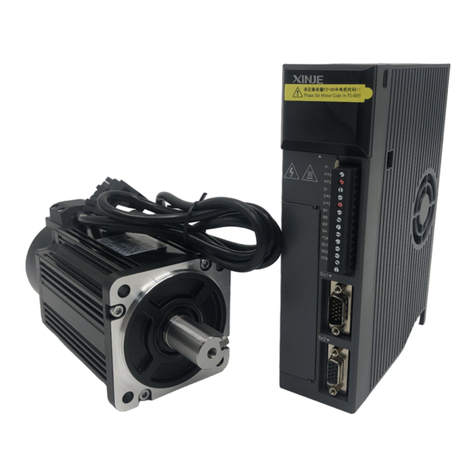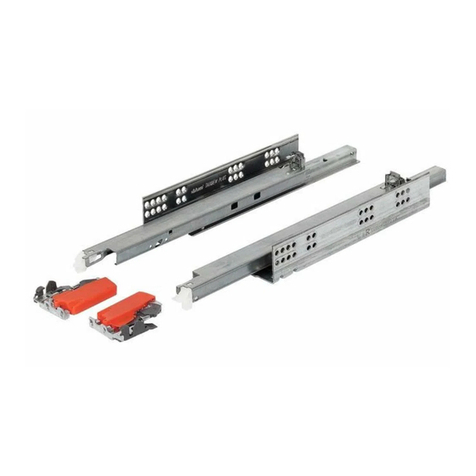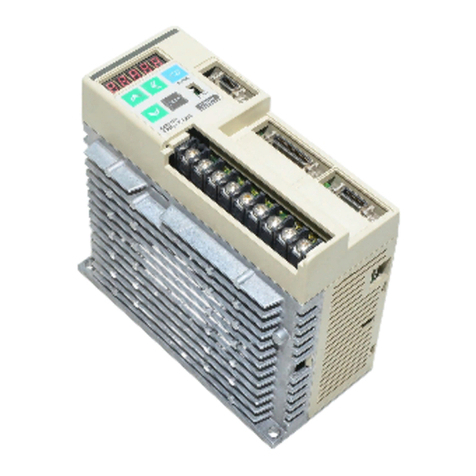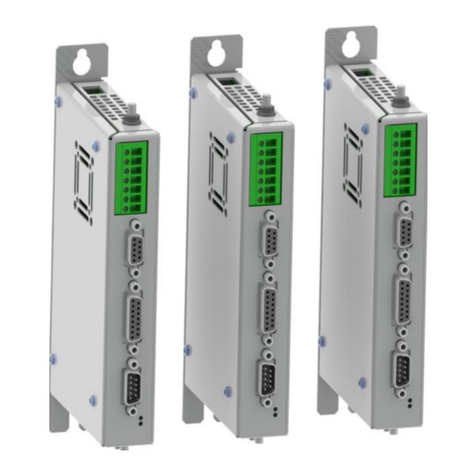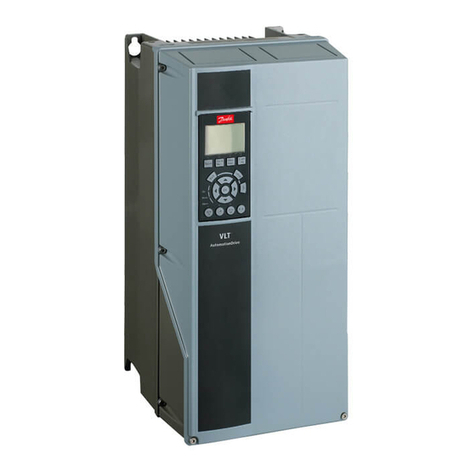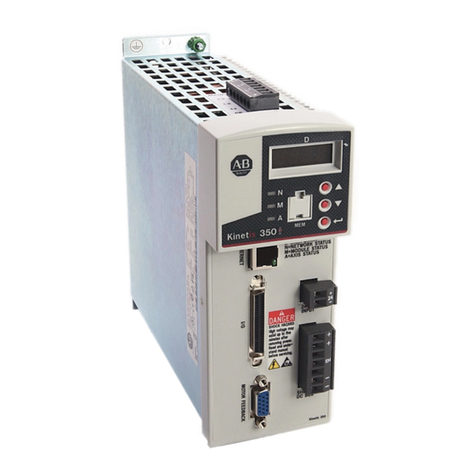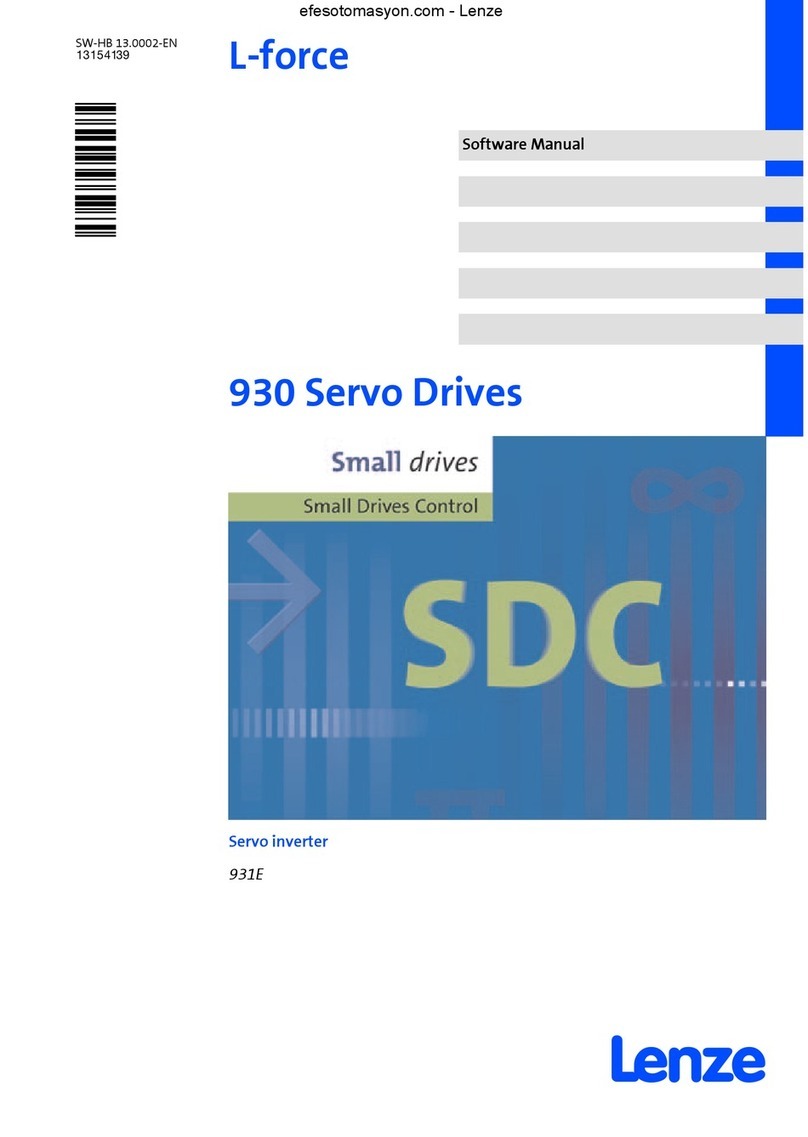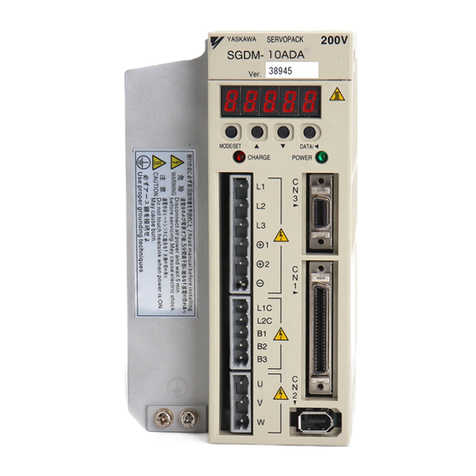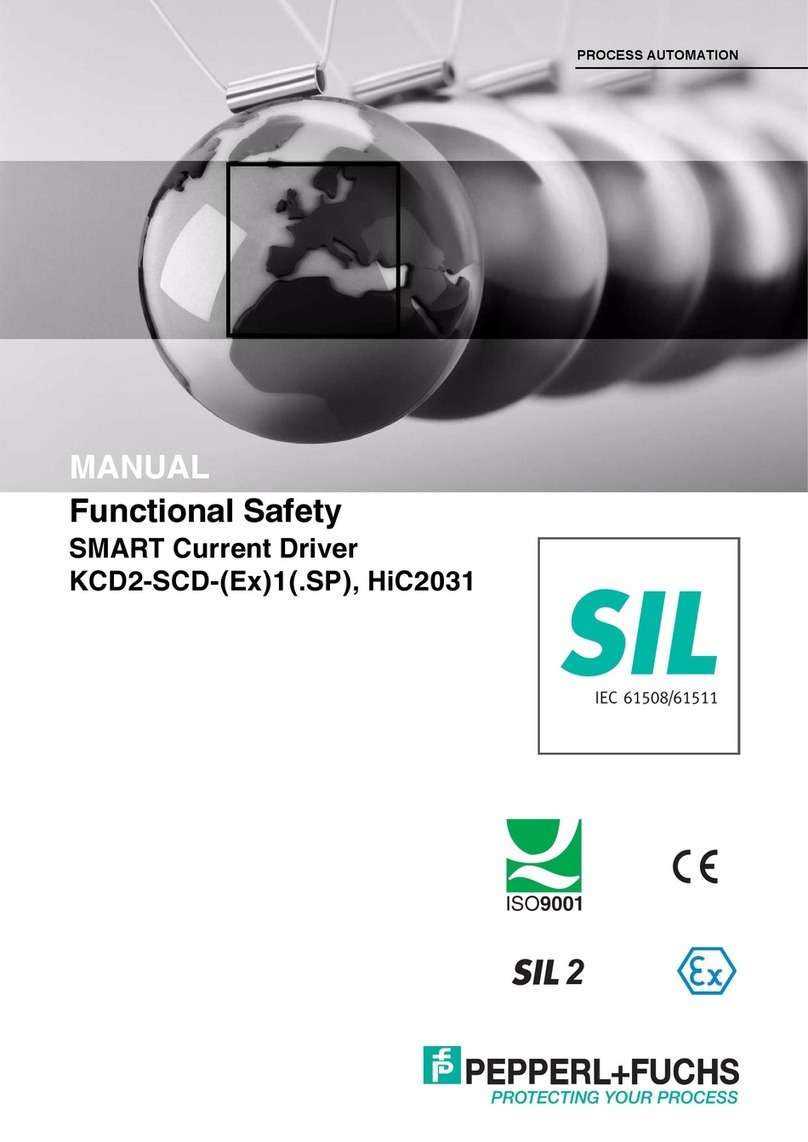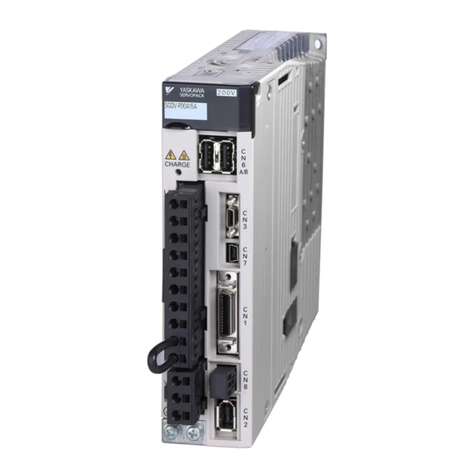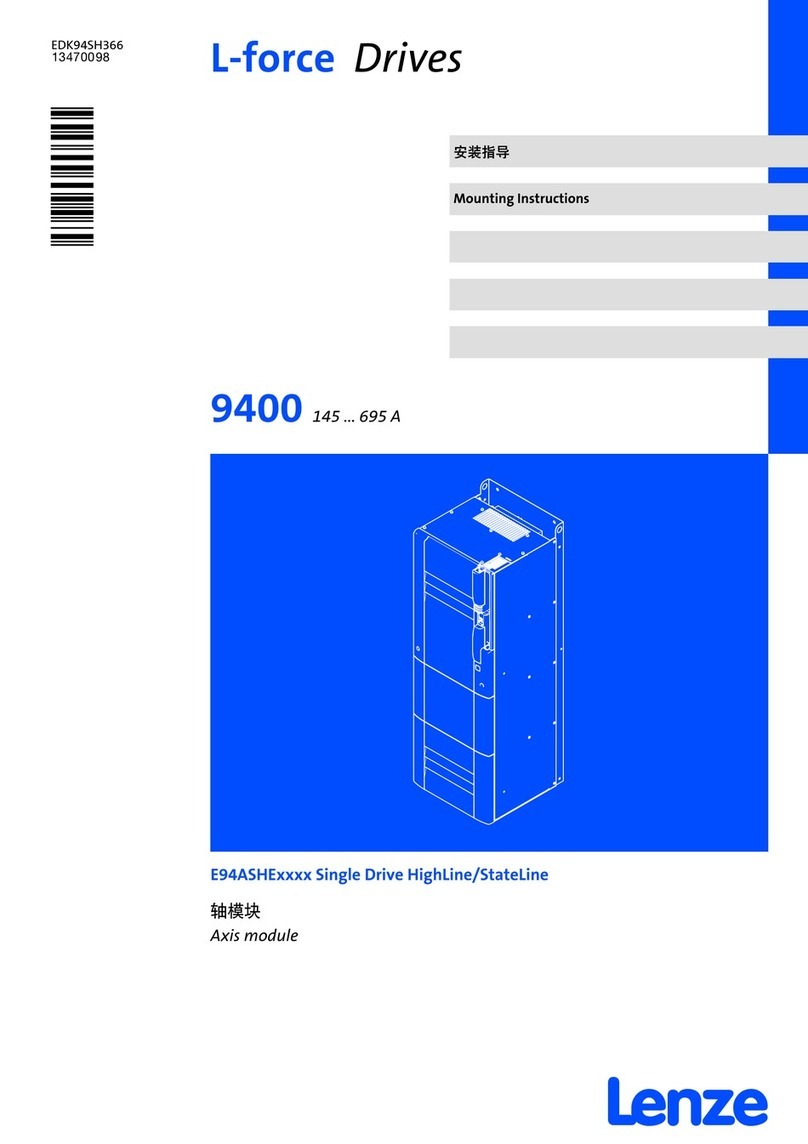Harmonic Drive HS-360 Series User manual

DC Servo Driver
HS-360 Series Technical Manual
● Thank you very much for your purchasing our HS-360 series
servo driver.
● Be sure to use sufficient safety measures when installing
and operating the equipment so as to prevent an accident
resulting in a serious physical injury damaged by a
malfunction or improper operation.
● Product specifications are subject to change without notice
for improvement purposes.
● Keep this manual in a convenient location and refer to it
whenever necessary in operating or maintaining the units.
● End user of the driver should have a copy of this manual.
ISO14001
(HOTAKA Plant)
ISO9001

Caution
HS Series
Safety guide for handling servomotors
Warning:Indicates a potentially hazardous
situation, which, if not avoided, could result in
death or serious personal injury.
CAUTION:Indicates a potentially hazardous
situation, which, if not avoided, may result in minor
or moderate personal injury and/or damage to the
Precautions when usin
g
an Actuato
r
APPLICATION DESIGN: Read the technical manual before designing.
Use it in designed conditions.
●The actuator must only be used indoors, where the following conditions are
provided:
-Ambient temperature: 0°C to 40°C
-Ambient humidity: 20% to 80%RH (Non-condensation)
-Vibration: Max 24.5 m/S2
-No contamination by water, oil or foreign matters
Follow exactly the instructions for installation.
●Ensure exact alignment of motor shaft center and corresponding center in
the application.
●Failure to observe this caution may lead to vibration, resulting in damage o
f
the bearings.
OPEARTION DESIGN: Read technical manual before o
p
eratin
g
Do not exceed the allowable torque.
●Avoid any torque over the maximum torque from being exerted.
●Be aware that if the arm hits the output shaft when coming into contact with it,
the output shaft may become uncontrollable, or the actuator may be damaged.
Warning
Never connect cables directly to the outlet or powe
r
supply.
●The actuator needs to be connected to the dedicated driver to operate.
●Never connect the actuator directly to the commercial power supply o
r
batteries, etc. The actuator ma
y
be dama
g
ed, resultin
g
in fire.
Protect the actuator from impact and shocks.
●Do not use a hammer to position the actuator during installation.
●Failure to observe this caution could damage the encoder and may cause
uncontrollable operation.
Avoid handling of the actuator by its cables.
●Failure to observe this caution may damage the wiring, causing
uncontrollable or faulty operation.
Precautions when usin
g
a Drive
r
APPLICATION DESIGN: Read the technical manual before designing.
Always use the driver in an environment where the
following conditions are provided.
●Keep sufficient distance to other devices to let the heat generated by the drive
r
radiate freely
*Mount in a vertical position
*Ambient temperature: 0°C to 50°C, humidity
: less than 95% RH (Non-condensations)
*Protect the driver from impact or shock.
*No corrosive, inflammable or explosive gas.
Provide sufficient noise suppression and safe grounding.
●Always keep signal wire away from noises to avoid vibration and malfunction.
*Keep signal and power leads separated.
*Keep leads as short as possible.
*Ground actuator and driver at one single point, minimum ground resistance
class: D.
*Do not use a power line filter in the motor circuit.
Caution
Be careful when turning from the load side.
●Be careful with turning the actuator from the output side as this may damage
the driver.
●Please consult our sales office, if you intent to use the product in such an
application.
Caution
Use a fast-response type ground-fault detector designed fo
r
PWM inverters.
●Do not use a time-delay-type ground-fault detector.
Warning
OPEARTION DESIGN: Read technical manual before o
p
eratin
g
Never change wiring while power is ON.
●Be sure to turn OFF power before servicing the product.
●Failure to observe this caution may result in electric shock or personal injury.
Warning
Do not touch the terminals right after turning off power.
●Otherwise residual electric charges may result in electric shock.
●Provide a housing for the control unit to avoid contact with electric parts.
Caution
Do not make a voltage resistance test.
●Failure to observe this caution may result in damage of the control unit.
●Please consult our sales office, if you intent to use in such an application.
Caution
Do not operate a control unit by means of power ON/OF
F
switching.
●Start/stop operation should be performed via input signals.
●Failure to observe this caution may result in deterioration of electronic parts.
Caution
Caution
Caution
Dis
p
osal of an actuator, a motor, a control unit or their
p
arts
Caution
All products or parts have to be disposed of as industrial waste.
LIMITATION OF APPLICATIONS:This equipment may not be used for the following applications.
*Space equipment *Aircraft, aeronautic equipment *Nuclear equipment *Amusement equipment, sport equipment, game machines *Vacuum equipment *
Automobile, automotive parts *Machine or devices acting directly on the human body *Instruments or devices to transport or carry people *Apparatus or devices
used in special environments *Explosion proof equipment
Please consult us, if you intend to use our products in one of the areas mentioned above.
Safety measures are essential to prevent accidents resulting in death, injury or damage of the equipment due to malfunction or
Caution
Caution
Caution

DC servo driver HS-360 Series
- Contents 1-
Contents
Chapter 1 Outline of HS-360 driver······························································································1
1-1 Main features··················································································································1
1-2 Ordering information of HS-360 driver ··········································································2
1-3 Combination with actuator·····························································································2
1-4 Specification of HS-360 driver·······················································································3
1-5 External drawing of HS-360 driver ················································································4
1-6 Names and functions of front panel components··························································5
Chapter 2 Connector pin layout···································································································7
2-1 TB1 power supply terminal pin layout·······································································7
2-1 TB2 actuator cable connection terminal pin layout···················································7
2-3 CN1 external I/O connector pin layout·······································································7
2-4 CN2 encoder and limit signal connector pin layout···················································8
2-5 CN3serial port connector pin layout EIA232C-compliant (RS-232C)·························9
Chapter 3 Control input/output··································································································10
3-1 command pulse input (CN1)························································································10
3-2 Selecting the command pulse input configuration ·······················································11
3-2-1 2-pulse train (FWD and REV pulse train)····································································11
3-2-2 1-pulse train (polarity + pulse train)············································································· 11
3-2-3 2-pulse train (2-phase pulses with 90-degree difference)···········································11
3-3 Control Input Signals (CN1, CN2)················································································12
3-3-1 CN1 input signal connection and functions·································································12
3-3-2 CN2 input signal connection and functions·································································14
3-4 Control output Signals (CN1, CN2)··············································································15
3-4-1 CN1 input signal connection and functions ································································15
3-4-2 CN2 input signal connection and functions(encoder monitor output) ·························17
3-5 Encoder input (CN2)····································································································18
3-6 External connection examples ····················································································19
Chapter 4 Installing driver ··········································································································21
4-1 Receiving Inspection ··································································································21
4-2 Notices on handling drivers························································································22
4-3 Location and installation·····························································································23
4-3-1 Environment of location······························································································23
4-3-2 Notices on installation·································································································23
4-3-3 Installing ······················································································································24
4-4 Suppressing noise·······································································································24
4-4-1 Devices for grounding ·································································································24
4-4-2 Installing noise filters···································································································25
4-4-3 Instructions for cabling ································································································26

DC servo driver HS-360 Series
- Contents 2-
4-5 Connecting power cables·····························································································27
4-5-1 Instructions for power supply······················································································27
4-5-2 Power cables and ground wires··················································································27
4-5-3 Connecting power cables ···························································································28
4-5-4 Isolation transformer (sold optionally)·········································································28
4-5-5 Protecting the power line····························································································29
4-6 Connecting the ground wire························································································29
4-7 Connecting the actuator cable····················································································29
4-8 Connecting cables for the encoder and the I/O··························································30
4-8-1 Preparing the encoder cable and the I/ O cable·························································30
4-8-2 Pin layout of external I/O connector (CN1)·································································30
4-8-3 Pin layout of encoder connector (CN2) ······································································30
4-9 Power on and off sequences······················································································31
Chapter 5 Operations··················································································································32
5-1 Trial run·······················································································································32
5-2 Usual operation ···········································································································34
5-2-1 Notices for daily operations ························································································34
5-2-2 Daily maintenance······································································································35
Chapter 6 Operating the display panel······················································································36
6-1 Outline of modes ········································································································36
6-2 Changing a mode·······································································································36
6-3 Monitor mode display details······················································································37
6-3-1 Servo state display ·····································································································37
6-3-2 Alarms ·······················································································································37
6-3-3 Resetting the alarm·····································································································37
6-3-4 Displaying the alarm history ·······················································································37
6-3-5 Clearing the alarm history···························································································37
6-4 Outline of parameter setup mode···············································································38
6-4-1 Operating parameter setup mode···············································································38
6-5 Outline of numeric monitor mode···············································································39
6-5-1 Numeric monitor list····································································································39
6-5-2 Displaying numeric monitor data················································································39
6-5-3 Clearing the torque peak ····························································································40
6-5-4 Displaying stop cause ·······························································································40
6-5-5 Displaying control state ······························································································40
6-5-6 Displaying I/O state ····································································································40
6-6 JOG operation mode···································································································41
6-6-1 JOG operations procedure ·························································································41
6-7 Displaying and setting data of high- and low-order digits············································43
Chapter 7 Parameter details·······································································································44
7-1 Default setup parameters···························································································44
7-2 Parameter details ·······································································································45

DC servo driver HS-360 Series
- Contents 3-
Chapter 8 Protective functions···························································································59
8-1 Outline of protective functions ··············································································59
8-2 Details of protective functions···············································································60
Chapter 9 Troubleshooting procedure and action····························································67
9-1 No rotation of actuator··························································································67
9-2 Unstable rotation of actuator·················································································68
9-3 Poor positioning accuracy····················································································70
INDEX··················································································································································72

DC servo driver HS-360 Series
Memo

Chapter 1 Outline of HS-360 driver
- 1-
Chapter 1 Outline of HS-360 drivers
Each HS-360 driver is available exclusively for an RH/RHS/RFS/LA/LAH Series actuator, consisting of
a combined system of a small-sized precision control reduction gear Harmonic drive®and small DC
servomotor.
HS-360 drivers have many features to exhibit fully the characteristics of each actuator.
1-1 Main features
●Easy parameter setting
Parameters have been set to match the driver with the actuator you have ordered. Users do not
need to make any settings for the actuator, except in case of using particularly specific
parameters.
For this driver, the parameters to optimize the higher-level system and controllability can easily
be set or changed by viewing “Parameter mode” the seven-segment LED display.
●Substantial monitoring functions
The status of operation can be continuously displayed as either “Status display mode” or
“Numeric monitor mode”, and the settings of the desired parameters can be monitored.
Information of “Command”, “Feedback”, and “Error counter”, specifically important for the servo
system, can be monitored.
Up to eight previous events of “Alarm history” can be shown, and also the process diagnosing a
problem can be viewed.
●Easy test operation
In “JOG mode”, operating buttons on the panel enables “JOG” operation.
●Electronic gear suitable for mechanical system
The electronic gear "Command pulse input factor" function adjusts commands to the feed pitch
or angle of the driven mechanism.
●Three types of input signals for position commands
Three types of input signals for the position command are selectable: “Two-pulse train”,
“Single-pulse train”, and “Two-phase pulse train”.

Chapter 1 Outline of HS-360 driver
- 2-
1-2 Ordering information of HS-360 driver
The HS-360 driver model indication and the mark shown in this manual are as follows:
1-3. Combinations with actuator
The following table lists the actuators that can be combined with HS-360 drivers:
Driver type
HS-360-1A
HS-360-1B
HS-360-1C
HS-360-1D
HS-360-3
Combined
Actuator
type
RH-5A-8802
RH-5A-5502
RH-5A-4402
(Linear Actuator)
LA-30B-10-F-L
LA-32-30-F-L
LAH-46-1002-F-L
LAH-46-3002-F-L
LNP-
XXX
-
XX
-R24A-
XXX
-DC(AL)
RH-8D-6006
RH-8D-3006
RH-11D-6001
RH-11D-3001
RHS-14-6003
RHS-14-3003
RH-14D-6002
RH-14D-3002
RHS-17-6006
RHS-17-3006
RHS-20-6007
RHS-20-3007
RHS-20-6012
RHS-20-3012
RHS-25-6012
RHS-25-3012
RFS-20-6007
RFS-20-3007
RFS-20-6012
RFS-20-3012
RFS-25-6012
RFS-25-3012
The 1000P/R line driver specification is recommended as the encoder resolution of DC servo actuators.
The encoder resolution for the RH-5A and linear series will be, however, the line driver specification of
360P/R or 500P/R.
HS-360-1M
DC servo driver HS series
360 Series
Rated output current
Maximum current types
A
1.0A
B
2.6A
C
3.7A
D
4.2A
Be sure to use a power supply voltage with the specified
voltage.
Otherwise, damage of driver or fire may occur.
Warning
1
1A or 1.4A
3
3A
Signal exchanges of the HS-360 series between the driver
and encoder are only with a line driver. Use at the open collector
is not feasible.
Caution

Chapter 1 Outline of HS-360 driver
- 3-
1-4 Specification of HS-360 drivers
Model
Item
HS-360-1A
HS-360-1B
HS-360-1B
HS-360-1D
HS-360-3
Rated output current (rms)
Note 1
1.0A
1.4A
3.2A
Maximum output current
(rms) Note 2
1.0A
2.6A
3.7A
4.2A
10A
Operating current
Single-phase AC100V±10%
50/60Hz
Controlling
PWM control (control element: IPM), switching frequency: 12.5kHz
Applicable position sensor
Incremental encoder (Phase-A, B, Z, output)
Line driver
Structure/installation
Self-cooling, Base mount (installing on the surface)
Control function
Positioning control by pulse train input
Maximum input pulse
frequency
400kp/s (Max)(line driver)
200kp/s(Max)(open collector)
Command pulse input
configuration
1 pulse, 2 pulse, 2-phase pulse
Control input signal
Servo on, Alarm reset, Error counter reset, Forward (FWD) inhibit, Reverse
(REV) inhibit
Control output signal
Ready, Alarm, In-position
Encoder monitor output
Phase Z open collector output. Phase-A, B, Z-voltage output (+5V).
Serial interface
EIA232C (RS232C) dedicated cable connection
Monitor
Operational status, alarm history, I/O, and parameters can be monitored.
The operation waveform can also be monitored with using the dedicated
software.
Protective functions
Memory failure, overload, encoder failure, regeneration failure, system
failure, over-current, excessive error, IPM failure, over-speed
Built-in circuit
Dynamic brake circuit, regeneration unit connection terminal Note 3
Built-in functions
Operated manually (JOG running, alarm history clear, etc.)
Ambient conditions
Service temperature: 0 to +50C
Service humidity: 90%RH or less
(non-condensation)
Vibration resistance: 4.9 m/s2
(10 to 55Hz)
Storage temperature: -20 to +85C
Storage humidity: 90%RH or less
(non-condensation)
Impact resistance: 98m/s2
Atmosphere: Must not contain any metal powder, dust, oil moisture, or
corrosive gas.
Mass
0.8kg
Note: The parameters have been factory-set in this product so that it operates as suitable for operation
of the actuator (i.e., motor) with which it combines. Do not use the product for any actuator other
than the preset one.
Note 1: Indicates the continuous output current from the driver.
This value is restricted, depending on the combination with the actuator.
Note 2: The maximum output current indicates the maximum momentary current.
This value is restricted, depending on the combination with the actuator.
Note 3: The regeneration unit is not required for the object actuator.

Chapter 1 Outline of HS-360 driver
- 4-
1-5 External drawing of the HA-360 drivers
The external drawing is shown below:
Unit:mm
●External drawing of the DC reactor 15mH
The following illustrations show the shape and dimensions of a DC reactor.
※Applicable to HS-360-3
Heat
sink
※A DC reactor of 15mH needs to be connected between
the driver and actuator when the HS-360-1A is used.
A DC reactor of 15mH will be supplied with the driver as
an accessory.
Detail of mounting hole

Chapter 1 Outline of HS-360 driver
- 5-
1-6 Names and functions of front panel components
●Display panel component names
●Functions of display panel component
◆LED display
Indicates operating states of the HS-360 driver, parameters, alarms, by a 5-digit 7 segment-LED.
◆[MODE], [DATA], [UP], and [DOWN] keys
Are used for changing indications, setting and tuning functional parameter values, and manual
JOG operation of actuators.
◆Charge voltage monitor
Indicate the monitored voltage of the power supply terminal. While the LED is on, do not touch
the terminal because it is at high voltage.
◆CN1: external I/O connector
Used to exchange control signals with the high-level controller.
Charge voltage monitor
MODE key
DATA key
LED display
UP key
DOWN key
TB1 power supply termin
TB1 grounding terminal
TB1 regeneration unit
connection terminal
TB2 actuator
connection terminal
CN3 EIA232C connector
(RS-232C)
CN4 (unavailable)
CN1: External I/O connector
CN2: Encoder connector

Chapter 1 Outline of HS-360 driver
- 6-
◆CN2: encoder connector
Used to connect the position detection encoder cable of the actuator or the cable of the
FWD/REV inhibit limit sensor.
(Enables the encoder signal output to be monitored.)
◆CN3: EIA232C (RS232C) serial port connector
Used for connection with a personal computer. Parameters can be set or changed, or the status
can be monitored through this connector. (The dedicated communication cable (sold optionally)
and software are necessary.)
◆CN4: Unavailable
Do not attempt to use this.
◆TB1: power supply terminal (R, T)
Power supply connection AC 100 V power supply terminals.
Be sure to use only the voltage not shown on the driver.
◆TB1: grounding terminal (E)
Used for grounding. To prevent electric shock, be sure to connect the ground wire to the ground.
◆TB1: external regeneration unit connection terminal (P, N)
If the start/stop frequency is high because the moment of inertia of the load is large and the
internal regeneration capacity is insufficient, a regeneration unit should be connected to this
terminal.
◆TB2: actuator connection terminal (+,-, E)
Used to connect the actuator lead wire. Associate the actuator colors and HS-360 driver symbols
with the proper counterparts. If the association contains an error, the driver or actuator may break.

Chapter 2 Connector pin layout
- -
7
Chapter 2 Connector pin layouts
2-1 TB1 power supply terminal pin layout
Pin No. Signal name Description
1RPower supply terminal
2TAC 100V, 50/60Hz
3EGrounding terminal
4P
5NRegeneration unit connection terminal
(1) Applicable terminal type for cable: Plug: 231-305/026-000 (manufacturer: WAGO)
(2) Applicable electric wire for cable: AWG14 (2.0mm2)
2-2 TB2 actuator cable connection terminal pin layout
Pin No. Signal name Description
1 +Actuator(+)connection terminal
2 NC Non-Terminating Terminal
3 -Actuator (-) connection terminal
4 EGrounding terminal
(1) Applicable terminal type for cable: Plug: 231-304/026-000 (manufacturer: WAGO)
(2) Applicable electric wire for cable: AWG16 (1.5mm2)
(3) Maximum wiring length: 10m
2-3CN1 external I/O connector pin layout
Pin
No. Signal
name Description
1 FWD+
FWD operation pulse (+) Inputs the command pulse.
2 FWD-
FWD operation pulse (-)
3 REV+
REV operation pulse (+) Inputs the command pulse.
Pulse
train
4 REV-
REV operation pulse (-)
5 ENABLE Servo On Turns on or off the servo.
6 ALM-RST Alarm Reset Resets the alarm output. Detected at the
edge.
7 CLEAR Error Counter Reset Resets the position error counter. Detected
at the edge.
Control
in
p
ut
8 IN-COM Input Signal Common Used to connect the common input signal.
9 READY Ready Output while excitation current is flowing
through the motor.
10 ALARM Alarm Output Output when an alarm occurs.
11 IN-POS In-Position Output when the position error is within the
preset range.
12 Z-IZ Encoder Phase-Z Phase-Z output from the encoder.
Control
out
p
ut
13 OUT-COM Output Signal Common Connect the common signal (0V) of output.
14 FG Frame Ground Connected to the frame and ground.
Refer to Chapter 3 for details.
(1) Applicable terminal type for cable: Cover: 10314-52F0-008
Plug: 10114-3000VE (manufacturer: 3M)
(2) Applicable electric wire for cable: 0.2mm2or more, shielded wire
(3) Maximum wiring length: 3 m or less
Be sure to use a power supply voltage with the specified
voltage.
Otherwise, the driver may break, or fire may occur.
Warning
P-N is a terminal to which the unit’s regeneration connector
should be connected. If another terminal is connected here, the
driver may break, or fire may occur.
Warning

Chapter 2 Connector pin layout
- -
8
2-4 CN2 encoder and limit signal connector pin layout
Pin No. Signal name Description
1
2
3
4
PG-Vcc Encoder +5V Power Supply +5V power to the encoder. Supplied from
the inside of the servo amplifier.
5
6
7
8
PG-0V Encoder Power Common Common terminal for the +5V power to
the encoder.
9 A Phase-A Input
10 A Phase-A Reversal Input
11 B Phase-B Input
12 B Phase-B Reversal Input
13 Z Phase-Z Input
14 Z Phase-Z Reversal Input
Input terminal for the encoder signals from
the actuator (line receiver input).
15 NC
16 NC
17 NC
18 NC
19 NC
20 NC
Non Terminating Terminal Note 3
21 EPG-Vcc Encoder External
(+5V) Supply Power Used to supply the +5V power from the
encoder from the outside. Note 2
Actuator encoder input
22 EPG-0V
Encoder External Supply Power
Common Common terminal to supply the +5V
power from the outside. Note 2
23 MON-Vcc +5V Encoder Monitor Power Used to supply the +5V encoder monitor
pulse from the outline.
24 MON-0V Encoder Monitor Power Common +5V power common terminal for encoder
monitor pulse output.
25 MON-A Encoder Monitor Phase-A Output
26 MON-B Encoder Monitor Phase-B Output
Monitor Output
27 MON-Z Encoder Monitor Phase-Z Output
Encoder monitor pulse output (open
collector output).
28 NC Non-Terminating Terminal Note 3
29 LMT-Vcc LMT Signal Power Used to supply the +24V limit input power
from the outside.
30 NC Non-Terminating Terminal Note 3
31 FWD-LMT FWD Inhibit Terminating terminal of FWD side rotation
limit switch.
32 NC Non-Terminating Terminal Note 3
33 REV-LMT LEV Inhibit Terminating terminal of REV side rotation
limit switch.
Limit input
34 NC Non-Terminating Terminal Note 3
35
FG
36 FG Frame Ground
Connected to the frame and power supply
grounding terminal.
Note 1: Connect the shielded wire to the connector's FG terminal or ground plate.
Note 2: When the internal encoder supply power voltage drops and it does not operate normally,
the external signal is supplied through this terminal. Use of this terminal requires changing
the driver's internal switch settings. For details of its use, consult with a business office of
Harmonic Drive Systems.
Note 3: Unavailable. Do not attempt to use this terminal
(1) Applicable terminal type for cable: Cover: 10336-52F0-008
Plug: 10136-3000VE (manufacturer: 3M)
(2) Applicable electric wire for cable: 0.2mm2or more shielded twisted pair cable
(3) Maximum wiring length: 10 m or less
-
-
-

Chapter 2 Connector pin layout
- -
9
2-5 CN3 serial port connector pin
EIA232C-compliant (RS-232C)
CN3 EIA232C(RS232C)
Pin No. Signal name Description
1 FG Frame Ground
2 RXD Receive Data
3 TXD Transmit Data
4 DTR Data Terminal Ready
5 GND Signal Ground
6 DSR Data Set Ready
7 RTS Request To Send
8 CTS Request To Send
※Connect the communication cable shielded wire to the Pin 1 [FG: Frame Ground].
(1) Applicable terminal type for cable: (driver)
Socket terminal: DF11-2428-SCF (manufacturer: Hirose)
Socket terminal: DF11-2428-SCF (manufacturer: Hirose)
(2) Applicable electric wire for cable: 0.2mm2shielded electric wire
(3) Maximum wiring length: 10m or less
(4) Configure the communication cables
Configure the communication cables according to the following figure:
● Personal computer monitoring
On a personal computer, various items of monitored information can be displayed, parameters
can be read and written, and the operational-status waveform can be displayed.
Personal computer software:
Software product name: PSF-520
Available in the Windows 2000 or XP environment
Sold optionally:
EIA232C (RS-232C) communication cable Model: HDM-RS232C
Shield wire
CN4 is an unavailable connector.
Attempting to use CN4 may cause the driver to break.
Caution
TXD
RXD
DTR
SG
DSR
RTS
CTS
FG
TXD
RXD
DTR
SG
DSR
RTS
CTS
HS-360
side Personal
Com
p
uter side

Chapter 3 Control input/output
- -
10
Chapter 3 Control input/output
3-1 Command pulse input (CN1)
This inputs the pulse train input to FWD+, FWD-, REV+, and REV-.
This section shows a connection with a line driver command and that with an open collector command.
The standard input current shall be 20mA, while the maximum input current shall be 30mA.
◆ Connection with a line driver command
◆ Connection with an open collector command
●For +5V external power ●For +24V external power
If the +24V supply voltage is used with an open collector command, the
connection must be made in a different way.
For the supply voltage, “+5V” is the standard. For “+24V”, add a 1kΩresistor serially
to the connection. If the 1kΩresistor is omitted, the driver may break.
Caution
Encoder signal processing
The HS-360 driver executes the internal feedback process with a signal that is
obtained by multiplying the encoder feedback signal by 4.
By default, the amount of movement is obtained by multiplying the encoder resolution
by 4 relative to the command pulse input count.
Caution
FG
220
1
2
220
3
4
1kΩ
1kΩ
HCPL-M611(HP)
HCPL-M611(HP)
14
HS-360
FWD+
FWD-
REV+
REV-
DC+5V
COM
(
0V
)
FWD command
pulse signal input
REV command
pulse signal input
Shielded
FG
220
1
2
220
3
4
1kΩ
1kΩ
HCPL-M611(HP 製)
HCPL-M611(HP 製)
14
HS-360
FWD+
FWD-
REV+
REV-
DC+24V
COM
(
0V
)
FWD command
pulse signal input
REV command
pulse signal input
1kΩ
1kΩ
Shielded
゙
FWD+
FWD-
REV+
REV-
FWD command pulse signal input
REV command pulse signal input
Equivalent to AM26LS31
HCPL-M611(HP)
HCPL-M611(HP)
FG
220
220
1kΩ
1kΩ
1
2
3
4
14
HS-360
Shielded

Chapter 3 Control input/output
- -
11
3-2 Selecting the command pulse input configuration
Two ports of CN1-1&2 and CN1-3&4 are available for pulse input signals. Each of the signals input
through these two ports has one of three pulse input configurations.
◆ Setting a command configuration
[Parameter setup mode]→[31: selecting the pulse input configuration]
3-2-1 2-pulse train (FWD and REV pulse train)
As shown in the figure, “FWD commands” are input through the “FWD” port, while “REV commands”
through the “REV” port. While the input is in progress, keep the other port “off”. This is also called the
“FWD and REV pulse train method”, and is the default setting.
3-2-2 1-pulse train (polarity + pulse train)
One pair of terminals is assigned dedicatedly for command pulse train, and the other is assigned to a
sign for rotary direction. Position commands are input in the “FWD” port pair only and the “REV” port
pair accepts the sign of rotary direction, as shown in the figure below. [Off] or [Low level] state is for
the FWD command and [On] or [High] level is for the REV command.
3-2-3 2-pulse train (A-B phase pulses with 90-degree difference)
Both port pairs receive the command pulse trains that have a 90-electronic-degree difference relative
to each other as shown in the figure below. For the “FWD command”, the pulse train to the “FWD”
ports advances 90 degrees from the REV port train. For the “REV command”, the “REV” port train
advances from the FWD port train.
Actuator encoder monitor signals are output according to this method.
REV command
Opti-isolator: Off
Opti-isolator: Off
FWD command
REV command
Opti-isolator: On
Opti-isolator: Off
FWD command
90°
REV commandFWD command
90°
FWD+
FWD-
REV+
REV-
220
1
2
220
3
4
FWD+
FWD-
REV+
REV-
220
1
2
220
3
4
FWD+
FWD-
REV+
REV-
220
1
2
220
3
4
If the other port is turned “on” while a command pulse is being input
through the port, the command pulse will be disabled when being
turned on.
Caution

Chapter 3 Control input/output
- -
12
● Multiplication of command
When the command configuration is a [2-phase
pulse] type, it is possible to multiply the
command pulse train by 2 or 4 for the
command pulse train to an actuator.
◆ Setting
[Parameter setup mode] →[42: multiplication of
2-phase pulse]
3-3 Control Input Signals (CN1, CN2)
This section shows connection examples and details of the functions with respect to the CN1 input
signals.
3-3-1 CN1 input signal connection and functions
The input signals are ENABLE, ALM-RST, and CLEAR.
The input circuit power supply is at DC 24V. (The input current is at approximately 10mA per circuit.)
Prepare it separately.
※ Values in ( ) are the values when 5V power supply is impressed.
External power supply of 5V is needed.
※ The voltage is set to 24V during preshipment inspection. Set all “1” to “4” on the DIP switch (DS1)
on the printed circuit board in the driver to “ON” when 5V power supply is impressed to the input circuit.
※ Select only 24V or 5V as voltage for external power supply.
(Single power supply voltage)
※
DIP switch state Control power
voltage
All ON 5V
All OFF 24V
470Ω
8
IN-COM
ALM-RST
ENABLE
CLEAR
DC24V
(
5V
)
0V
External supply voltage
A
larm Reset
ENABLE
Error Counter Clea
r
5
6
7
14
2.7KΩ
(400Ω)
HS-360
2.7KΩ
(
400Ω
)
2.7KΩ
(
400Ω
)
470Ω
470Ω
FWD
REV
1
In
p
ut si
g
nal
Double
Quadruplicated
23 4
1
1
2 3 4 5 6 7 8
2 3 54 6 7 8 9 10 11 12 13 14 15 16
FG
Shielded
Confi
g
uration of DIP switch DS1 on
p
rinted circuit board
DS1

Chapter 3 Control input/output
- -
13
CN1-5 Servo on: ENABLE
◆ Functions
(1) This signal turns on/off the driver circuit of the HS-360 driver.
When this input is on, the driver servo goes on, causing the driver to be ready. When it is off, the
servo goes off, causing the servo to be free, or the dynamic brake to be active.
(2) The dynamic brake on/off selection can be made by selecting [Parameter setup mode] →[46:
Dynamic brake on/off].
(3) The logic can be changed by selecting [Parameter setup mode] →[38: Input pin logic]. The default
is 0 (CLOSE), and the signal is meaningful.
(4) If [Parameter setup mode] is selected and 1 is selected in [41: CLEAR signal functions], the error
counter is also cleared and the error pulse count is set to 0.
◆ Connection
(1) For the input circuit power supply, prepare DC 24V separately.
(2) The input current is at approximately 10mA per circuit.
CN1-6 alarm reset: ALM-RST
◆ Functions
(1) When an alarm occurs
The alarm is cleared, and the driver is made ready. The edge is used for detection. If an
unclearable alarm occurs, turn off the power once. In this case, turn the power on again after
removing the cause of the alarm.
(2) The logic can be changed by selecting [Parameter setup mode] →[38: Input pin logic]. The default
is 0 (CLOSE falling edge), and the signal is meaningful.
(3) If [Parameter setup mode] is selected and 1 is selected in [41: CLEAR signal functions], the error
counter is also cleared and the error pulse count is set to 0.
Connection
(1) For the input circuit power supply, prepare DC 24V separately.
(2) The input current is at approximately 10mA per circuit.
CN1-7 error counter clear: CLEAR
◆ Functions
(1) Clear the error counter, and set the error pulse count to 0.
(2) The logic can be changed by selecting [Parameter setup mode] →[38: Input pin logic]. The default
is 0 (CLOSE falling edge), and the signal is meaningful.
(3) If [Parameter mode] is selected and 0 is selected in [41: CLEAR signal functions], this input signal
will be enabled. If 1 is selected there, it will be disabled.
◆ Connection
(1) For the input circuit power supply, prepare DC 24V separately.
(2) The input current is at approximately 10mA per circuit.

Chapter 3 Control input/output
- -
14
CN1-8 input signal common: IN-COM
◆ Function
This is a common signal to “CN1-5, -6, and -7”, and supplies power form the outside for input
signals.
◆ Connection
The externally supplied voltage for input signals is “+24V”.
3-3-2 CN2 input signal connection and functions
FWD-LMT and REV-LMT are available for input signals.
No running torque is generated at the terminal through which this signal is being input.
For the input circuit power, prepare DC 24V separately (the current consumption is approximately
10mA per circuit).
CN2-31 FWD inhibit: FWD-LMT
CN2-33 REV inhibit: REV-LMT
◆ Functions
(1) FWD (or REV) inhibit: The actuator does not generate any forward (or reverse) torque while the
input signal is being generated. If both of the input signals are generated, the actuator
generates neither forward nor reverse torque. The inputs may be used to limit the motion range
between limit sensors.
(2) All pulses that are input to the detected portion during limit sensor detection are ignored.
(3) The logic can be changed by selecting [Parameter setup mode] →[38: Input pin logic]. The default
is 0. When the input signal causes the opti-isolator to be on, the limit function works.
◆ Connection
(1) For the input circuit power supply, prepare DC 24V separately.
(2) The input current is at approximately 10mA per circuit.
CN2-29 LMT signal power: LMT-Vcc
◆ Function
FWD-LMT and REV-LMT are power supply terminals.
◆ Connection
Connect the 24VDC external power.
470Ω
Shielded
LMT-VCC
FWD-LMT
REV-LMT
29
31
33
DC+24V max
35/36
HS-360
470Ω
2.7KΩ
2.7KΩ
FG
Table of contents
Other Harmonic Drive Servo Drive manuals
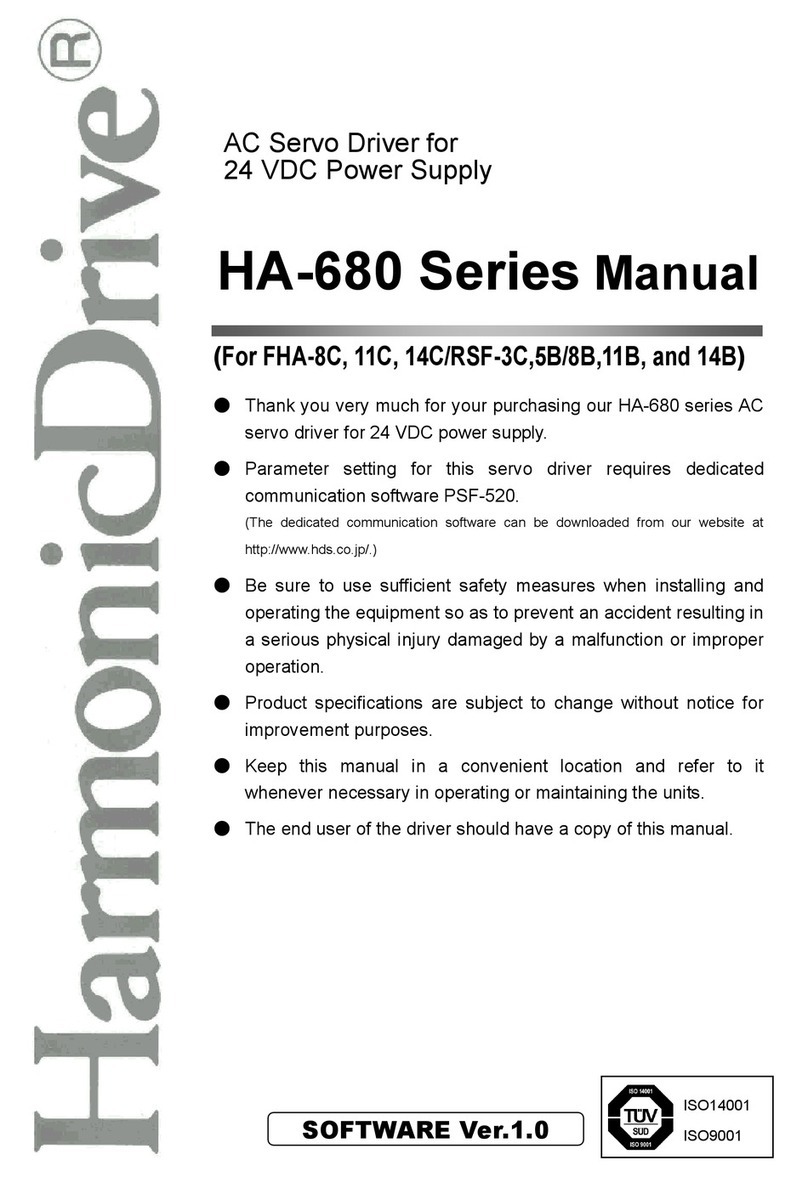
Harmonic Drive
Harmonic Drive HA-680 Series User manual

Harmonic Drive
Harmonic Drive LAH Series User manual
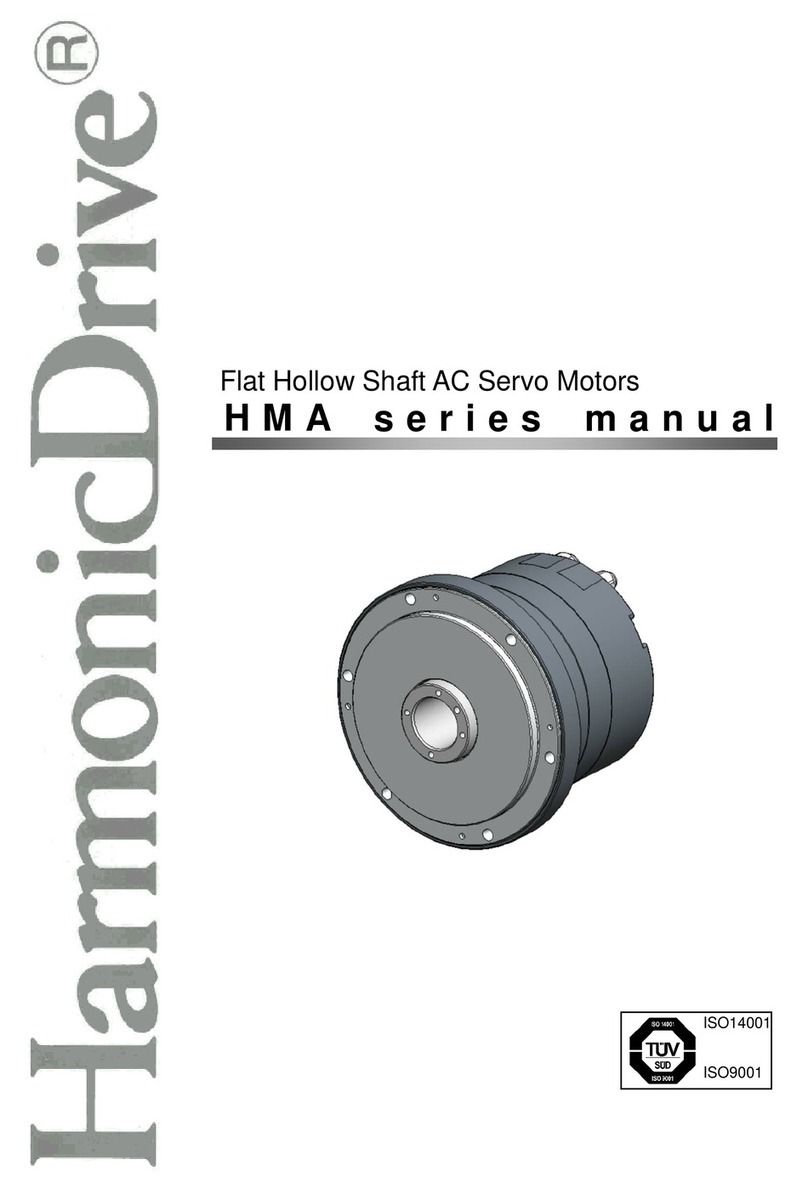
Harmonic Drive
Harmonic Drive HMA Series User manual

Harmonic Drive
Harmonic Drive HA-520 Series User manual
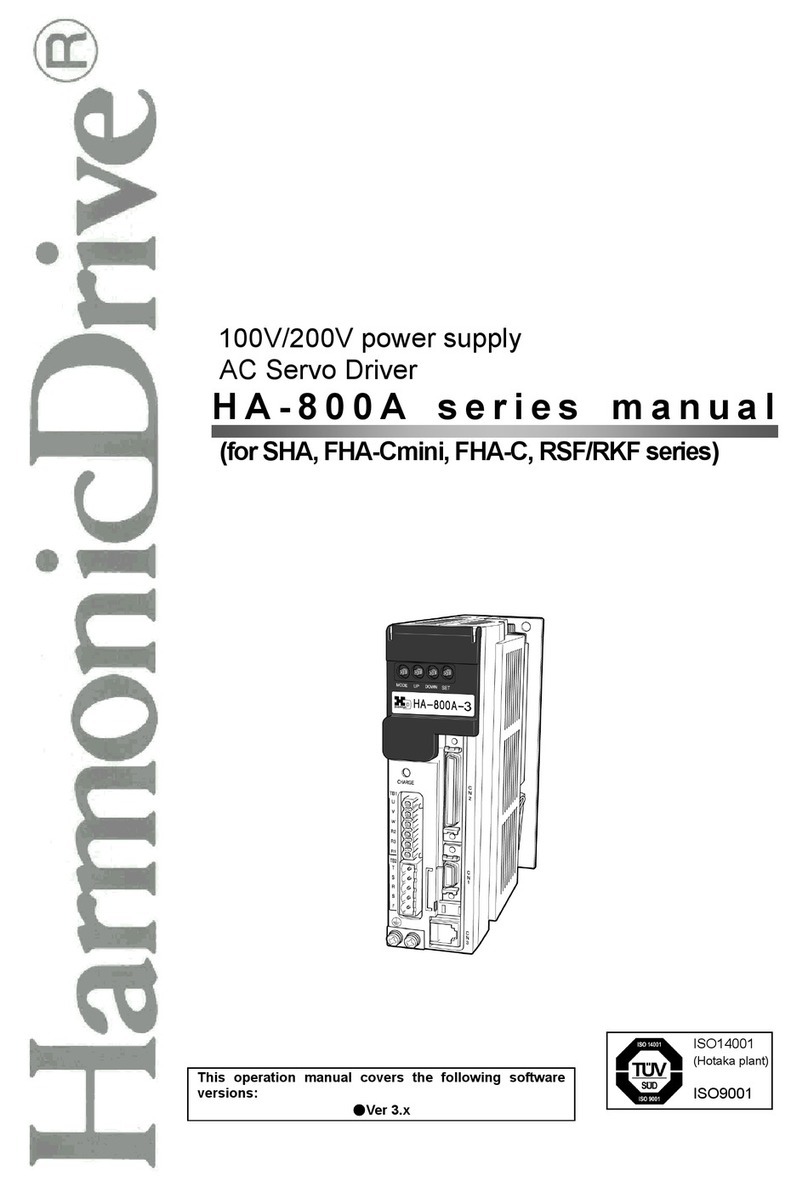
Harmonic Drive
Harmonic Drive H A - 800A User manual
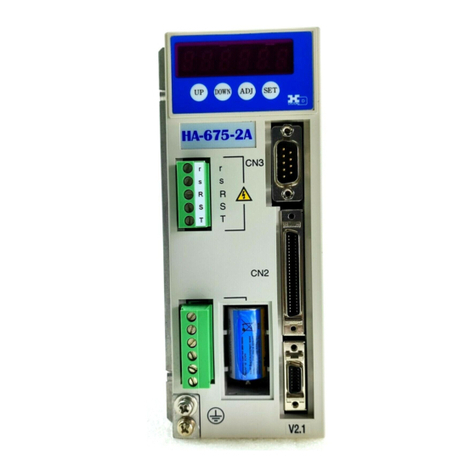
Harmonic Drive
Harmonic Drive HA-675 Series User manual
Popular Servo Drive manuals by other brands
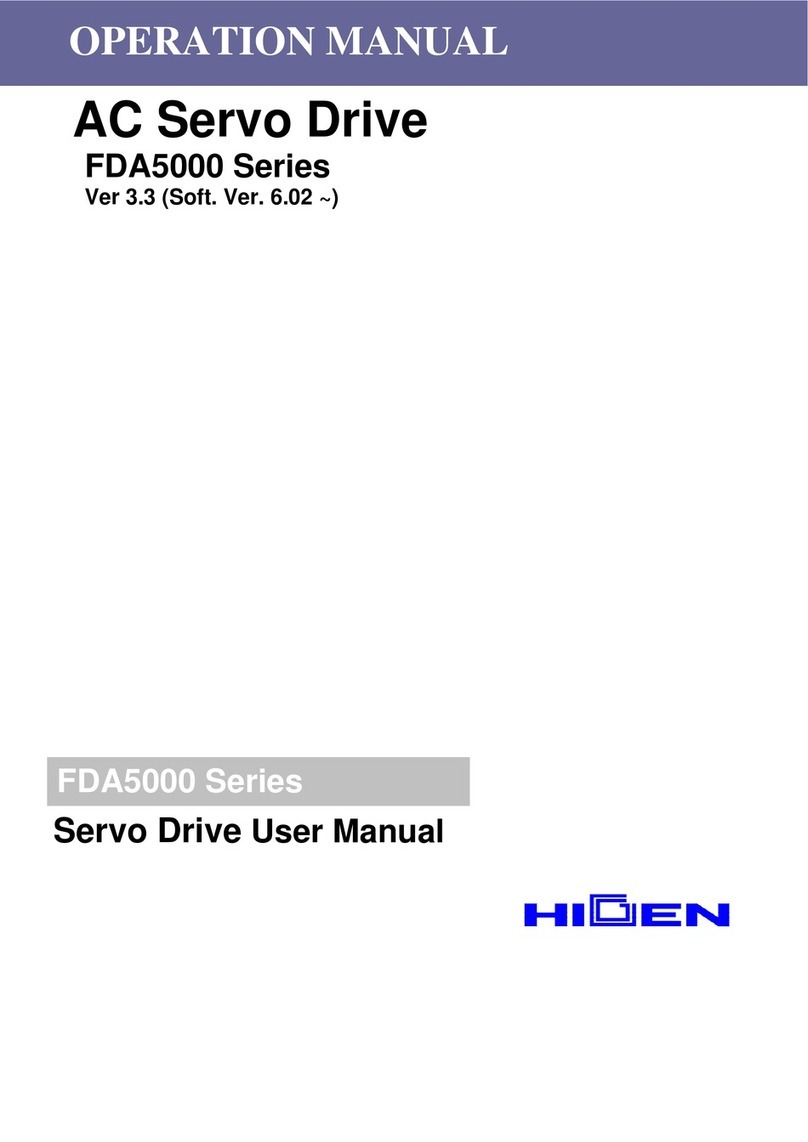
Higen
Higen FDA5000 Series Operation manual
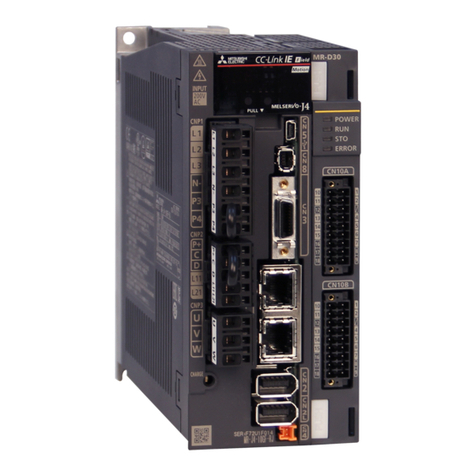
Mitsubishi Electric
Mitsubishi Electric MR-D30 instruction manual
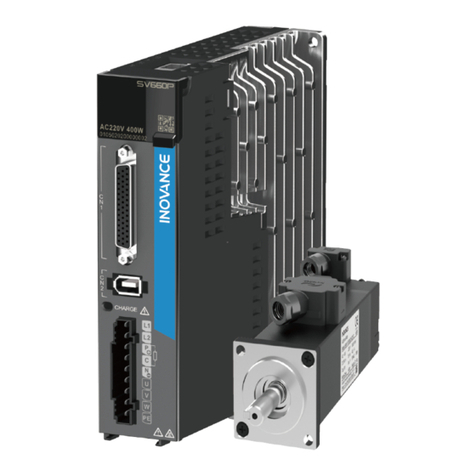
Inovance
Inovance SV660P Series Hardware guide
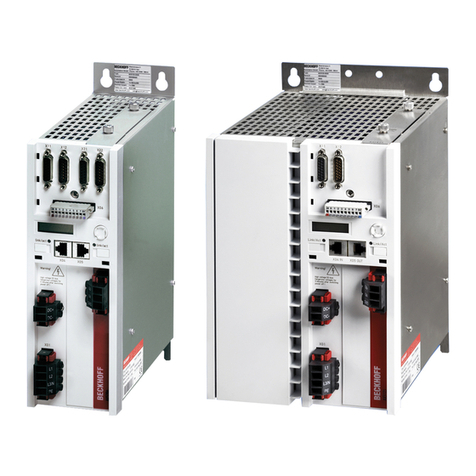
Beckhoff
Beckhoff AX5000 Series Function manual
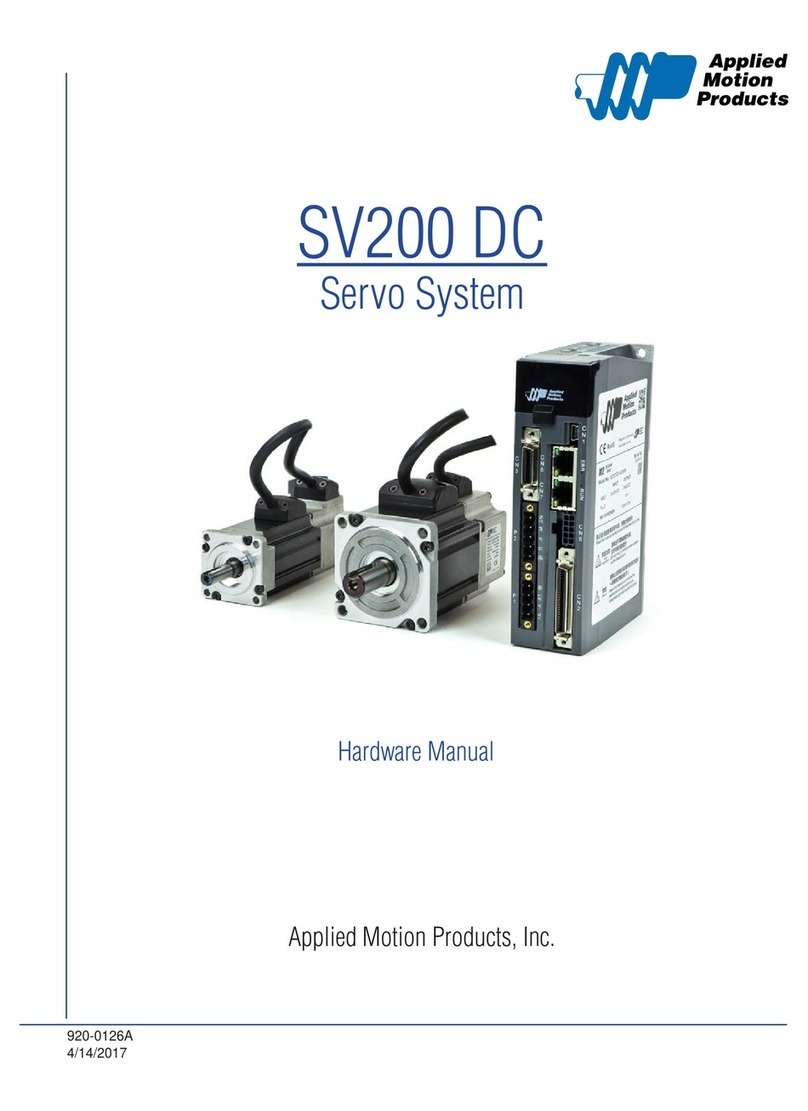
Applied Motion Products
Applied Motion Products SV200 DC Hardware manual
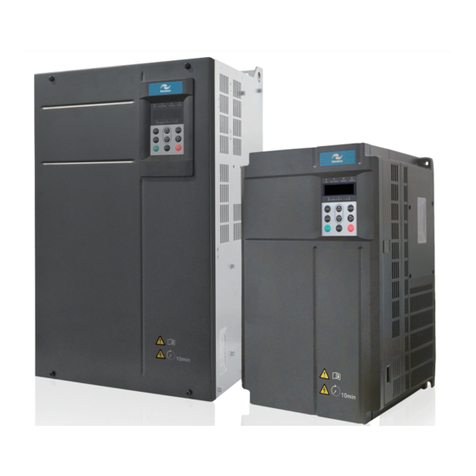
Inovance
Inovance IS580 Series user guide
